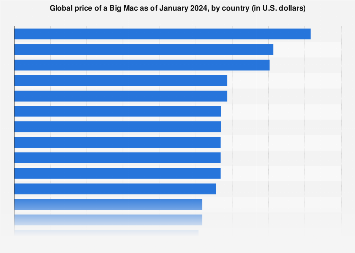
At 8.17 U.S. dollars, Switzerland has the most expensive Big Macs in the world, according to the January 2024 Big Mac index. Concurrently the cost of a Big Mac was 5.69 dollars in the U.S., and 5.87 U.S. dollars in the Euro area.
What is the Big Mac index?
The Big Mac index, published by The Economist, is a novel way of measuring whether the market exchange rates for different countries’ currencies are overvalued or undervalued. It does this by measuring each currency against a common standard – the Big Mac hamburger sold by McDonald’s restaurants all over the world. Twice a year the Economist converts the average national price of a Big Mac into U.S. dollars using the exchange rate at that point in time. As a Big Mac is a completely standardized product across the world, the argument goes that it should have the same relative cost in every country. Differences in the cost of a Big Mac expressed as U.S. dollars therefore reflect differences in the purchasing power of each currency.
Is the Big Mac index a good measure of purchasing power parity?
Purchasing power parity (PPP) is the idea that items should cost the same in different countries, based on the exchange rate at that time. This relationship does not hold in practice. Factors like tax rates, wage regulations, whether components need to be imported, and the level of market competition all contribute to price variations between countries. The Big Mac index does measure this basic point – that one U.S. dollar can buy more in some countries than others. There are more accurate ways to measure differences in PPP though, which convert a larger range of products into their dollar price. Adjusting for PPP can have a massive effect on how we understand a country’s economy. The country with the largest GDP adjusted for PPP is China, but when looking at the unadjusted GDP of different countries, the U.S. has the largest economy.



